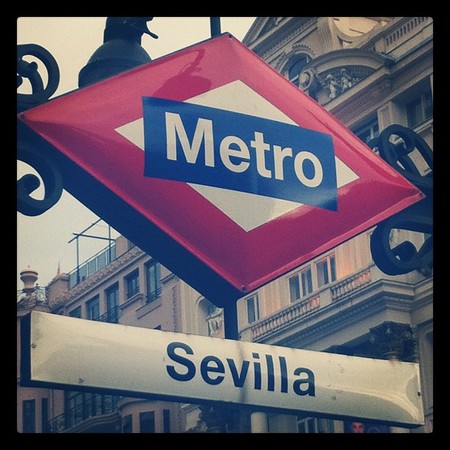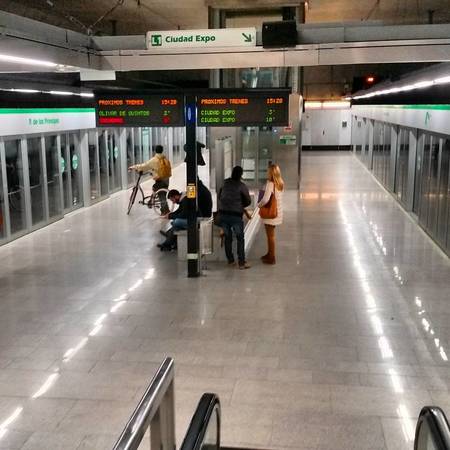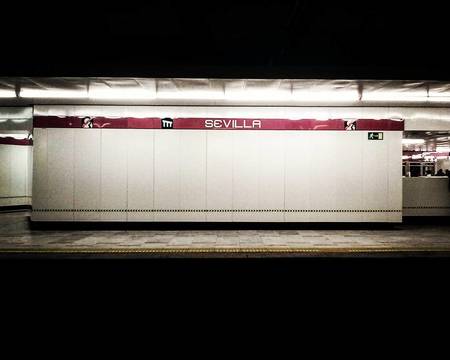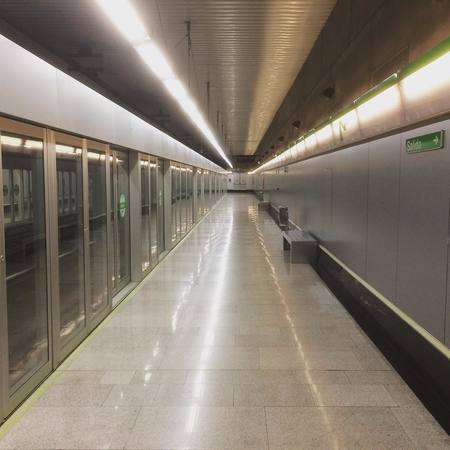With more similarities to a light rail than a subway, the Seville Metro consists of an 18-kilometer operational line and 22 stations. Providing its service to the city since 2009.
Serving more than 15 million travellers annually. It’s an interconnected system with trams and buses.
Depending of the day of the week, the trains start working at 6:30 at the earliest and the system shuts down at 2 of the morning at the latest day it closes. The price for the cheapest normal ticket is 1,35 € for a trip on the same route.
Currently, the Seville Metro has no direct connection with the airport.
Metros in Spain: Seville Metro
With a population of more than 1.500.000 habitants in its metropolitan area, Seville is placed as the fourth city with the biggest population in Spain, just behind Madrid, Barcelona and Valencia.
The city specially stands out for its historical delights and architecture, some of its environments had been declared as World Heritage by the UNESCO, reason why it attracts thousands of tourists every year.
Likewise, it is important to spotlight the important urban development which the Andalusian capital has been getting over the last decades, promoting the establishment, not only the tourist industry, but also areas like, university education, services and industrial parks.
For this reason, the municipal authorities had been forced to create transportation systems to cover the current necessities of the metropolis, among them, the Seville Metro stands out.
This work dates back to 1960, when the possibility of building a massive transportation system was proposed for the first time, strong enough to attend the future growth of the people of Seville.
After multiple incomplete studies, the project was forgotten in the 90s decade. With the beginning of the new millennium the discussions on the feasibility of the Seville Metro came back. In 2003 the construction of the subway system began, although it is considered a subway, it has the features of a light rail because of its sizes.
Right now, it has 1 operational line providing a service to some neighborhoods of the city through its 18 kilometers distributed in 22 stations, and being functional since 2009, time when the work was finished.
 Sevilla Metro
Sevilla Metro
Besides, 3 more lines are expected, to connect as many people of Seville as possible. These projects don’t have initial nor end date yet.
Lines
The Seville Metro counts with only one commercial route right now, although there are three others being planned. The Line number 1, which is the one completely operational, it has 21 stations distributed in 18,2 kilometers of permanent way.
Joining towns from Montequinto, Mairena de Aljarafe and San Juan de Aznalfarache, including the center of Seville of course.Carrying more than 15 million travellers every year, according to the latest calculations of the system administrators, attending a population of 858.000 citizens approximately, depending on the covered locations.
Trains have an approximate speed of 70 km/h. Its fleet is compounded by 21 vehicles providing their daily service in this system.
Stations
- Ciudad Expo Station: Located in the town of Mairena de Aljarafe – specifically in front of Centro Comercial Metromar (Metromar Shopping Center), in the Av. de los Descubrimientos. The station opened its doors on April 2, 2009.
- Cavaleri Station: This stop is located near the Plaza de Jagüey Grande, in the town of Mairena del Ajarafe, and its inauguration was on April 2, 2009.
- San Juan Alto Station: This stop is inside Urbanización Montelar in the town of San Juan de Aznalfarache. Opened its doors on April 2, 2009.
- San Juan Bajo Station: This station is located in the Barrio Bajo, which belongs to the town of San Juan de Aznalfarache. It was inaugurated on April 2, of 2009.
- Blas Infante Station: Located in the Blas Infante avenue, near the Parque de los Príncipes, in Los Remedios district. The time of its opening was in April 2, 2009.
- Parque de los Príncipes Station: Placed in Los Remedios district, in the avenue República Argentina, this station was opened on April 2, 2009.
- Plaza de Cuba Station: This stop is placed in the República Argentina avenue, inside the district Los Remedios. It was opened on April 2, 2009, like the ones before.
- Puerta Jerez Station: It’s located in the Paseo de Cristina, of district Casco Antiguo, its opening was in 2009, on April 2.
- Prado de San Sebastián Station: The station is located in the vicinity of the Av. de Carlos V, in the Casco Antiguo district. Opened its doors on April 2, 2009.
- San Bernardo Station: This is one of the stations with the greatest number of passengers thanks to its location in Nervión district. It was inaugurated on April 2, 2009.
- Nervión Station: It is in Nervión district, specifically in the Av. de Eduardo. It opening date was on April 2, 2009.
- Gran Plaza Station: As the one before, this station is located in Av. de Eduardo of Nervión district, inaugurated in April 2, 2009.
- 1º de Mayo Station: The stop is located in the Cerro-Amate district, in the Federico Mayo Gavarre avenue. Opened its doors on April 2, 2009.
- Amate Station: Providing its service in Cerro-Amate district, in the avenue of the Gavilanes. Like the previous ones, started working on April 2, 2009.
- La Plata Station: It’s located in Cerro-Amate district, also in the avenue of the Gavilanes, operating since April 2, 2009.
- Cocheras Station: The station is located in the vicinity of Parque de la Música, of Cerro-Amate district, being inaugurated in April 2, 2009.
- Pablo de Olavide Station: The station is just in front of the Universidad de Pablo de Olavide, it was named after it, and was opened on April 2, 2009.
- Condequinto Station: Located in the town of Dos Hermanas, in the Urbanización Condequinto, serving since November of 2009.
- Montequinto Station: Also in the town of Dos Hermanas, the stop lies in the avenue of Condequinto, operating since November, 2009.
- Europa Station: Like the one before, this stop is placed in the town of Dos Hermanas, in the avenue of Montequinto, and it has been operating since November, 2009.
- Olivar de Quintos Station: Located in the avenue of Condes de Ybarra, in the town of Dos Hermanas, it is one of the final stations of the Seville Metro, serving since November of 2009.
 Metro Sevilla
Metro Sevilla
Connections
The Seville Metro has an excellent interconnection with other transportation systems operating in the city, from tramways, to city and intercity buses. The city’s authorities had been focused in creating a public transportation framework to complement its multiple modalities. Attending as much passengers as it can.
Then, these are the different connections the system has:
- Ciudad Expo Station: Intercity buses M-101, M-150, M-151, M-152, M-153, M-154A, M-154B, M-155.
- Cavaleri Station: Intercity buses M-150, M-151, M-152, M-153, M-155.
- San Juan Alto Station: Intercity buses M-150, M-151, M-152, M-153, M-155.
- San Juan Bajo Station: Intercity Buses M-101, M-150, M-151, M-152, M-153, M-154A, M-154B, M-155.
- Blas Infante Station: City buses 41, A2, LC. Intercity buses M-140, M-150, M-151, M-152, M-153, M-162.
- Parque de los Príncipes Station: City buses 5, 6, C1, C2. Intercity buses M-140, M-150, M-151, M-152, M-153, M-162.
- Plaza de Cuba Station: City buses 5, 40, A2. Intercity buses M-140, M-150, M-151, M-152, M-153.
- Puerta Jerez Station City buses: 3, 5, 6, 37, 41, C3, C5. Tramway T1.
- Prado de San Sebastián Station: City buses 1, 21, 22, 23, 25, 26, 28, 29, 30, 31, 34, 36, 37, 41, C1, C2, C3, C4, EA, L2, A5, N28, N29. Intercity buses M-121, M-122, M-123, M-130, M-131, M-132, M-132B, M-133, M-134, M-221. Tramway T1.
- San Bernardo Station: City buses 22, 25, 26, 28, 29, 38, 52, C-2, B4, EA. Tramway T1. Renfe C-1, C-4, C-5 (Connection with rail terminals of the same name).
- Nervión Station: City buses 5, 22, 28, 29, 32, B3, B4, C1, C2, EA, A4. Intercity buses M-220.
- Gran Plaza Station: City buses 5, 22, 29, 32, 52, A4, B3, B4. Intercity buses M-121, M-122, M-221.
- 1º de Mayo Station: City buses 5, 24, 52.
- Amate Station: City buses 24, 25, 52.
- La Plata Station: City buses 25.
- Cocheras Station: City buses 26.
- Pablo de Olavide Station: City buses 38. Intercity buses M-123, M-130.
- Condequinto Station: Intercity buses M-123, M-130.
- Olivar de Quintos Station: Intercity buses M-130, M-133.
Montequinto and Europe stations do not have direct connection with other means of city or intercity transportation.

Schedule
The Seville Metro offers a very convenient schedule to those who are recreational and visit the city, operating in different times with the intention of satisfying the user’s needs.
- Monday to Thursday: The trains start serving without pause from 6:30 a.m. to 11:00 p.m.
- Friday and eve of holidays: The vehicles start functioning without stopping since 6:30 a.m. until 2:00 a.m.
- Saturday: During these days the trains start working continuously from 7:30 a.m. to 2:00 a.m.
- Sunday and holidays: During holidays and Sundays, the trains operate from 7:30 a.m., taking passengers until 11:00 p.m.
On average, the users of the subway system use to wait between 8 and 10 minutes during normal hours. Nevertheless, in rush hours, the vehicles increase their frequency, reducing the time wait to 4 to 6 minutes per train.
Fares
The fare system of the Seville Metro is attached to the route the user takes from one point to another in the system. Yet, the fare won’t be attached to the amount of travelled kilometres, but the number of sections the passenger passes. In this way, the subway is divided in three sections:
- Section 0: Expo-Blas Infante City.
- Section 1: Blas Infante - Pablo de Olavide.
- Section 2: Pablo de Olavid - Olivar de Quintos.
The passage between one section and another is called “jump”, this is why you can see in fares “0 jumps” if the passenger doesn’t leave from a same section, “1 jump”, if the traveller only goes from on section to another – and “2 jumps” if the user goes through all sections.

Now well, the prices managed by the administrators are:
- Normal Ticket: It’s the simplest option to travel in the metro, only allowing a single trip in the trains with a maximum time limit of one hour and a half from the moment it’s validated in the turnstiles. It has a price of 1,35 € for “0 jumps”, 1,60 € “1 jump” and 1,80 € “2 jumps”.
- Round Trip: This ticket allows the passenger to take trips in the system, being able to acquire it in any of the expending machines in subway stations. It’s validated for an hour and a half (for each trip) from the moment it goes through the turnstiles. It has a price of 2,70 € “0 jumps”, 3,20 € “1 jump” and 3,60 € “2 jumps”.
- One-day bonus: This is the best choice for those who want to use the Seville Metro massively during a full day, it allows unlimited trips and jumps until the system closes. It can only be used by the user who acquires it and it has a price of 4,50€.
- Plus 45 Bonus: This mode allows the passengers to take 45 trips, for 30 days from the moment it is bought. Its individual, so the ticket can only be used by the passenger who acquires it. The monthly payment will vary depending on how many jumps are chosen, being 30 € “0 jumps”, 42 € “1 jump”, and 50 € “2 jumps”.
- Metrobonus: This is a prepaid card that allows you to take as many trips as you want, as long as your balance is high enough. It can only be used by the user who acquires it and the card must have a minimum balance of 10 €, with the possibility of wiring a maximum of 50 €. Each trip has a price of 0,82 € for “0 jumps”, 1,17 € “1 jump” and 1,37 € “2 jumps”.
Rules
- Anyone inside the Seville Metro, in the trains as well as the station environments, must have a valid ticket.
- Users under 3 years old are exempt of paying to travel in the Seville Metro.
- The users of the subway system are not allowed to smoke in the facilities or trains.
- You are not allowed to eat or drink in the stations or trains of the system.
- It is strictly prohibited to operate emergency devices without the occurrence of an event that merits it.
- Must avoid entering or leaving the wagons once the acoustic signal has been activated.
- You cannot alter the public order during the trip on the train; this is: bothering, acting violent or threat other passengers with insults, physical aggression or other forms of violence.
- You cannot use roller skates or skateboards within the Seville Metro’s facilities.
- The distribution of propaganda, pamphlets or event announcements within the metro’s facilities without previous authorization by the system managers.
- Begging is prohibited inside the facilities or trains of the system.
- Damaging the subway stop’s furniture will be penalized as damage to private property, applicable penalties will be imposed.
- Bicycles are allowed inside the Seville Metro’s trains, although during rush hours, the staff in charge can deny the access of these vehicles with the objective of ensuring the comfort of other passengers.
Connection to the Airport
The Seville Metro does not have a direct connection to the Seville Airport – although there are plans of constructing an extension to the aerial terminal -, For this reason the users have to take another complementary mean of transportation. Nonetheless, it is possible to go to the aerial compound from some metro stations, being Prado de San Sebastián the most important one.
Now, in case of deciding this option, the user will need to go the mentioned station and go to the bus stops after leaving the subway, which has many different destination choices.
It is necessary being alert with the route EA (Especial Aeropuerto) which means “Special Airport”, this is the one in charge of taking passengers from the metro to the airport. These buses operate from 4:30 a.m. until midnight. You can travel in them by paying 4 €, which is the price of the normal ticket, and the trip lasts around 40 minutes.
On the other hand, if your intention is to get to the center of Seville from the airport taking advantage of the public transportations in the city, the trip will be quite similar. When you arrive to the terminal, you will have to leave the place and find a bus stop where the line EA passes by, it won’t be difficult since you would be just in front of the building.
Once located the mentioned bus stop, you will need to wait until one of these vehicles arrives, always make sure you are within an operational schedule. Therefore, the bus trip is not the only alternative available in the Seville Airport to get to the center of the metropolis. You will also find taxi lines and car renting companies, these are very convenient in case you have a significant amount of luggage.
Future enlargements
The Seville Metro is expected to have 3 lines in the near future, being line 2 the one which will have greater improvements. The last one is already planned, the communities are being informed where the line will be built. According to the authorities, so far, the route will cover areas of Torreblanca, Sevilla Este, Santa Justa, Downtown and Puerta Triana. It has also been discussed the possibility that this one will connect with the airport, although nothing conclusive has been said.
For its part, the line 3 will attend the neighborhoods of Pino Montano, Macarena, Ronda Histórica, Prado de San Sebastián, La Palmera y Bermejales. This route is in planning stage, so it could be modified, furthermore, there are more studies to be done on the practicability of this project.
In the meanwhile, line number 4 will have a round form, connecting the other routes of the Sevilla Metro, but its projection is in its primary phase, which is why it has not even been decided if it will go underground or on the surface. In any case, the studies will start after the ones for line 3.
Touristic places
The city of Seville has a lot to offer to its visitors, since it counts with theaters, squares, cinemas and entertainment facilities to that end. It is a tourist metropolis par excellence, where the visitors will be able to contemplate its architecture, what demonstrates the transitions of Spain in its different historical events.
One of the most emblematic places in Seville would be Plaza España, located within a few meters from the Prado de San Sebastián station. It is the perfect site to enjoy all the surrounding edifications, regard the view and integrate yourself into the multiculturalism of the very place.
Equally, near the same stop, there is the beautiful palace of Real Alcázares, where several gardens and areas built in different ages lie. It was declared as World Heritage Site by UNESCO in 1987, bringing more than 1.7 million of tourists every year. Its construction dates back to the High Middle Ages, going through important periods of the history of Spain and preserving itself in a very good shape until today, thanks to the frequent catering given by the authorities of Seville. Without doubt, this palace should be marked on the road maps of any tourist.
Seville metro map
- Passengers/Day
- Fares:
- 24h operation: No
- Air Conditioning: No
- Walk between platforms: No
- Driverless trains: No
- Screen Doors Platforms: Line 1
- Max. Speed: 70km/h
- Operator: Ferrocarriles de la Junta de Andalucía
- 1
- Seville Metro Official Website
Help us
If you consider that the information we provide is wrong, not accurated, outdated, translation contains errors, and you would like to help us to improve the file...you can contact us here.
Feel free to contact us if you dont find the system you're looking for and we'll add it as soon as we can!
Thank you very much!







